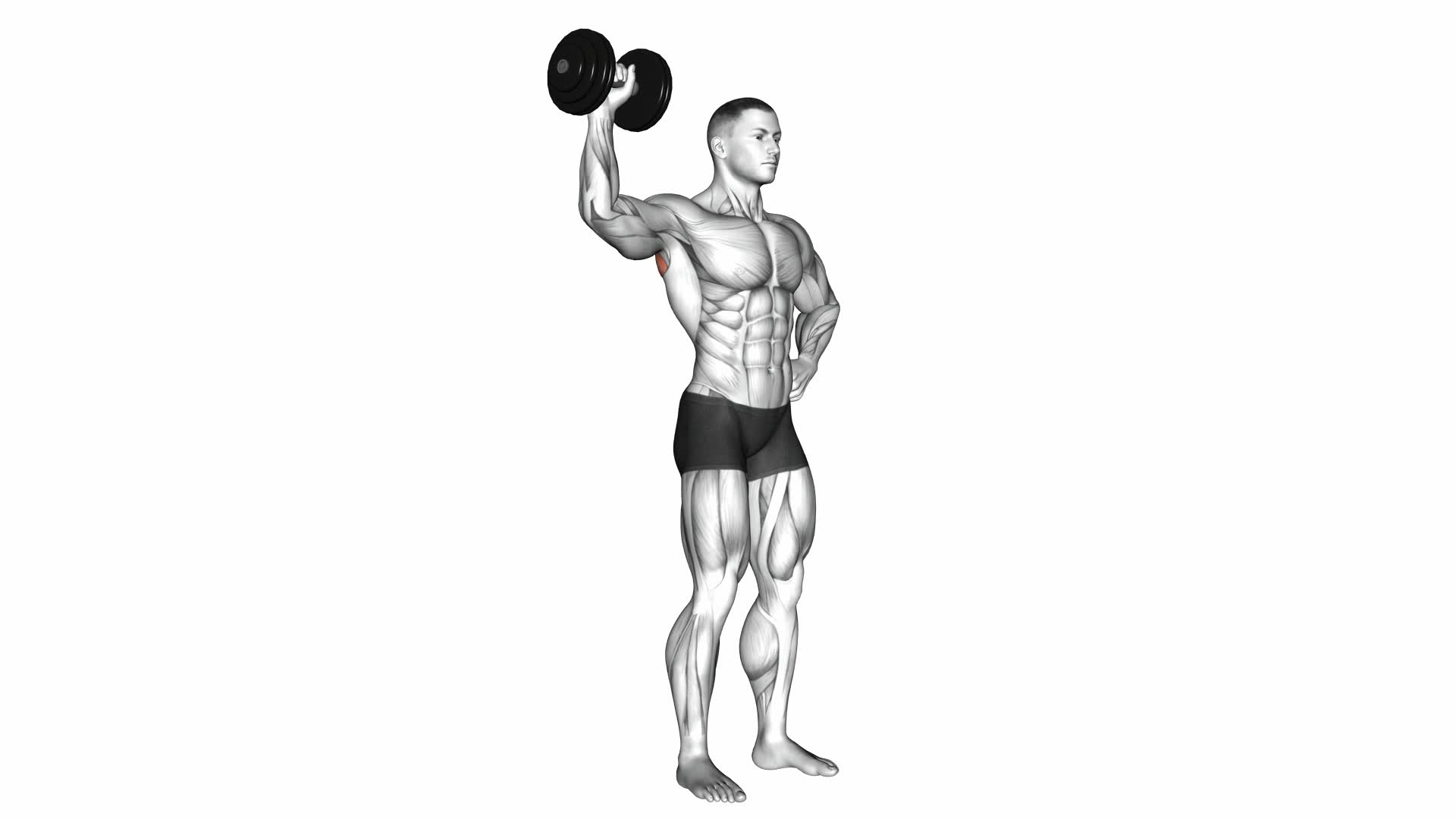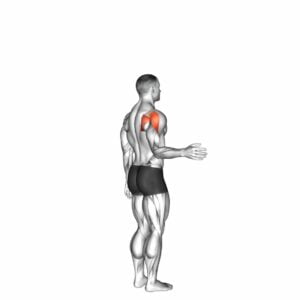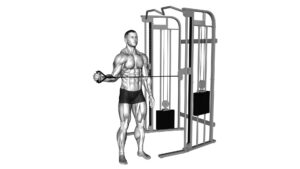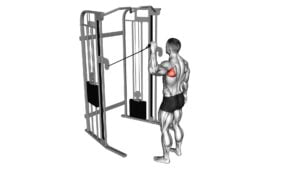Dumbbell Upright Shoulder External Rotation – Video Exercise Guide & Tips

Are you looking for an effective way to strengthen and stabilize your shoulders? Look no further than the dumbbell upright shoulder external rotation exercise.
Watch This Exercise Video
In this video exercise guide, we will show you the proper technique and form to perform this exercise correctly. By incorporating this exercise into your routine, you can improve your shoulder mobility and reduce the risk of injury.
Get ready to take your shoulder workout to the next level!
Key Takeaways
- Dumbbell upright shoulder external rotation strengthens shoulder muscles, particularly the rotator cuff muscles.
- This exercise improves shoulder stability and proper movement, reducing the risk of shoulder injuries.
- It enhances shoulder mobility and range of motion while alleviating shoulder pain and discomfort caused by muscle imbalances or tightness.
- To maximize the effectiveness of the exercise, start with lighter weights, maintain proper form, and consult with a fitness professional or physical therapist for personalized advice.
Benefits of Dumbbell Upright Shoulder External Rotation
You should regularly perform dumbbell upright shoulder external rotations to maximize the benefits for your shoulder muscles. This exercise targets the muscles in your shoulders, particularly the rotator cuff muscles, which are essential for shoulder stability and proper movement. By strengthening these muscles, you can reduce the risk of shoulder injuries and improve your overall shoulder function.
One of the key benefits of dumbbell upright shoulder external rotations is improved shoulder mobility. This exercise helps to increase the range of motion in your shoulders, allowing you to perform daily activities with greater ease and efficiency. Additionally, it can help to alleviate shoulder pain and discomfort caused by muscle imbalances or tightness.
Another advantage of this exercise is that it can be easily modified to suit your fitness level and goals. You can vary the weight of the dumbbell, the number of repetitions, and the tempo of the exercise to make it more challenging or less intense. This versatility makes it suitable for individuals of all fitness levels, from beginners to advanced athletes.
Now that you understand the benefits of dumbbell upright shoulder external rotations, let's move on to the equipment and set-up for the exercise.
Equipment and Set-up for the Exercise
To properly perform the dumbbell upright shoulder external rotation exercise, you'll need a set of dumbbells and a stable surface to support your body. Here is a step-by-step guide on the equipment set up and technique tips for this exercise:
- Select the appropriate dumbbell weight: Choose a weight that challenges your shoulder muscles but still allows you to maintain proper form throughout the exercise. Start with lighter weights and gradually increase as you build strength and confidence.
- Stand tall with a neutral spine: Position yourself in an upright stance with your feet shoulder-width apart. Engage your core muscles to maintain stability and prevent any excessive movement.
- Hold the dumbbell in your hand: Grasp the dumbbell with an overhand grip, keeping your wrist neutral. Your elbow should be bent at a 90-degree angle, with your upper arm parallel to the floor.
- Perform the external rotation: While keeping your upper arm stationary, rotate your forearm outward, away from your body. Pause for a moment at the end of the movement, feeling the contraction in your shoulder muscles.
Remember to start with a light weight and focus on proper technique to avoid any strain or injury. As you become more comfortable with the exercise, you can gradually increase the weight to continue challenging your shoulder muscles.
Proper Form and Technique for the Exercise
To ensure proper form and technique for the dumbbell upright shoulder external rotation exercise, focus on maintaining a stable upper arm while rotating your forearm outward. This exercise targets the external rotators of the shoulder, which are important for maintaining proper shoulder alignment and preventing injuries.
To perform the exercise correctly, start by standing with your feet shoulder-width apart and holding a dumbbell in one hand. Keep your elbows bent at a 90-degree angle and your upper arm parallel to the floor. This is your starting position.
From here, exhale and slowly rotate your forearm outward, away from your body. Keep your upper arm stable and avoid any movement or swinging. Inhale as you return to the starting position, and repeat for the desired number of repetitions.
Common errors when performing the dumbbell upright shoulder external rotation exercise include using too much weight, allowing the upper arm to move, and not fully extending the forearm outward. These errors can lead to improper form and reduced effectiveness of the exercise.
Variations and modifications for this exercise include using different weights, performing the exercise seated or with a resistance band, and adjusting the range of motion based on individual needs or limitations. It's important to consult with a fitness professional or physical therapist to determine the appropriate variations or modifications for your specific needs.
Common Mistakes to Avoid During the Exercise
A common mistake to avoid during the dumbbell upright shoulder external rotation exercise is using excessive weight, which can compromise proper form and increase the risk of injury. To ensure you're performing the exercise correctly and safely, here are some common mistakes to avoid:
- Swinging the dumbbell: It's important to maintain control throughout the movement. Avoid using momentum or swinging the weight, as this takes away from the targeted muscles and reduces the effectiveness of the exercise.
- Shrugging the shoulders: Keep your shoulders relaxed and down throughout the entire movement. Shrugging can lead to unnecessary tension in the neck and traps, taking away from the focus on the rotator cuff muscles.
- Lifting the elbow too high: When performing the external rotation, make sure to keep your elbow at shoulder level. Lifting the elbow too high can shift the emphasis to other muscles and reduce the effectiveness of the exercise.
- Not engaging the core: Proper core engagement is crucial for stability and proper form. Failing to engage your core muscles can lead to compensation from other muscle groups and increase the risk of injury.
By avoiding these common mistakes, you can ensure that you're performing the dumbbell upright shoulder external rotation exercise with proper technique and maximize its effectiveness.
Now, let's move on to some tips to further enhance the benefits of this exercise.
Tips to Maximize the Effectiveness of the Exercise
To maximize the effectiveness of the dumbbell upright shoulder external rotation exercise, focus on maintaining proper form and incorporating these tips.
One common misconception is that using heavier weights will yield better results. However, it's important to start with lighter weights and gradually increase the resistance as your strength improves. This will help prevent injury and ensure that you're targeting the correct muscles.
Another tip is to vary the angle of the exercise. Instead of always performing the exercise in a seated position, try standing or kneeling to engage different muscles in your shoulders and upper back. Additionally, you can modify the exercise by using resistance bands instead of dumbbells. This will provide a different type of resistance and challenge your muscles in a new way.
Remember to keep your core engaged and your shoulders relaxed throughout the exercise. Avoid shrugging your shoulders or arching your back, as this can lead to strain or injury.
Lastly, be consistent with your training and gradually increase the number of repetitions and sets over time. By following these tips and incorporating variations and modifications, you can maximize the effectiveness of the dumbbell upright shoulder external rotation exercise.
Frequently Asked Questions
How Often Should I Incorporate Dumbbell Upright Shoulder External Rotation Into My Workout Routine?
To determine how often you should incorporate dumbbell upright shoulder external rotation into your workout routine, it's important to consider your fitness goals and current level of strength.
This exercise is typically performed 1-3 times a week, with 2-3 sets of 8-12 repetitions per set.
If you don't have dumbbells, you can definitely perform this exercise with a resistance band instead. Just make sure to choose a band with appropriate resistance for your fitness level.
Can I Perform This Exercise With a Resistance Band Instead of Dumbbells?
Yes, you can perform this exercise with a resistance band instead of dumbbells. Using a resistance band as an alternative can provide unique benefits to your workout routine.
Resistance bands allow for a greater range of motion and can engage different muscle groups. Additionally, they're portable and versatile, making them a convenient option for exercising at home or on the go.
Is There a Modified Version of This Exercise for Individuals With Shoulder Injuries or Limitations?
If you have shoulder injuries or limitations, there's a modified version of this exercise that can be used for shoulder rehabilitation.
This modified version focuses on gentle movements and uses lighter weights or resistance bands to reduce strain on the shoulder.
It's important to consult with a healthcare professional or a certified trainer who specializes in rehabilitation exercises to ensure proper form and prevent further injury.
How Long Should I Hold the Top Position of the Exercise Before Lowering the Dumbbell?
To maximize the benefits of the dumbbell upright shoulder external rotation exercise, you should hold the top position for a few seconds before lowering the dumbbell. This helps to strengthen and stabilize the shoulder muscles.
Holding the top position engages the muscles for a longer duration, promoting muscle growth and improved control. By adding this pause, you can enhance the effectiveness of the exercise and get closer to achieving your fitness goals.
Can I Perform This Exercise Seated Instead of Standing?
Yes, you can perform this exercise seated instead of standing.
Seated dumbbell upright external rotation offers several benefits. It provides stability and support to your back, allowing you to focus on targeting your shoulder muscles.
This variation also reduces the involvement of other muscle groups, making it more isolated and effective for shoulder strengthening.
Conclusion
In conclusion, the dumbbell upright shoulder external rotation is an effective exercise for strengthening and stabilizing the shoulder muscles.
By using proper form and technique, you can maximize the benefits of this exercise and avoid common mistakes.
Remember to start with a weight that allows you to maintain proper form and gradually increase the weight as you become stronger.
Incorporating this exercise into your fitness routine can help improve shoulder strength and prevent injuries.

Author
Years ago, the spark of my life’s passion ignited in my mind the moment I stepped into the local gym for the first time. The inaugural bead of perspiration, the initial endeavor, the very first surge of endorphins, and a sense of pride that washed over me post-workout marked the beginning of my deep-seated interest in strength sports, fitness, and sports nutrition. This very curiosity blossomed rapidly into a profound fascination, propelling me to earn a Master’s degree in Physical Education from the Academy of Physical Education in Krakow, followed by a Sports Manager diploma from the Jagiellonian University. My journey of growth led me to gain more specialized qualifications, such as being a certified personal trainer with a focus on sports dietetics, a lifeguard, and an instructor for wellness and corrective gymnastics. Theoretical knowledge paired seamlessly with practical experience, reinforcing my belief that the transformation of individuals under my guidance was also a reflection of my personal growth. This belief holds true even today. Each day, I strive to push the boundaries and explore new realms. These realms gently elevate me to greater heights. The unique combination of passion for my field and the continuous quest for growth fuels my drive to break new ground.







